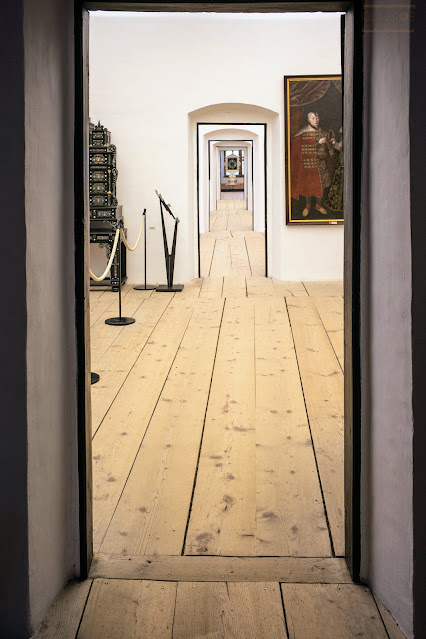The Forchtenstein Castle is some 80 or 90 Kms from Vienna, south of Mattersburg, above the Wulka valley, in Northern Burgenland, Austria. It is near my home, clearly shown on the map, and very accessible by road. So, when looking at the map trying to figure out where to go on a beautiful sunny Sunday in May, the castle looked inviting; after having seen it, I wished I had done it earlier.
My expectation of a castle built in the middle ages is normally a kind of fortress that has been attacked a thousand times and is more or less in ruins, though it may still keep a few walls. I would also expect to see partially reconstructed parts of it with more or less success. They may have a moat, usually a prison tower that also comes with stories of the famous people who were imprisoned there. The Forchtenstein was never overcome by the enemy (especially the Turks) becoming a huge residential castle kept in pristine condition, a museum of war artefacts, paintings and all kinds of objects from the middle ages up to the 18th century, a place of history, art, and beauty.
It is impossible to give in one page a summary of the 500 years of history that has gone through this castle. The castle offers a guided tour that tells about the people that built it and lived in it for centuries. What follows is an attempt to briefly summarize - through excerpts of various sources - the history of the castle and its owners.
The first part of the castle, was built at the beginning of the 15th century by the Lords of Mattersburg (nearby town) who were later known as the Lords of Forchtenstein - still remembered through the story of ”The cruel Rosalia von Forchtenstein, or: Salah he!” (1). When their dynasty died around 1450, it was passed over to the House of Habsburg (2) one of the most prominent and important dynasties in European history, who kept it for 170 years.
In 1622, the Emperor Ferdinand II passed the castle over to Nikolaus Estherházy, founder of the western Hungarian Estherházy line who became a Count. The Estherházy family refurbished the castle and, through generations, principally through his son Prince Paul, in the 17th century, finished the renovation of the castle and furnished it with much of its treasure, making it the repository of weapons, military equipment and art objects. A secret vault was built to keep the accumulated treasures, a vault that remained undiscovered through World War II. Many of these objects are today on display on the third floor. Prince Paul had 26 children (with two wives) of which only a few survived to adulthood. After Paul's death in 1713, no noble family ever lived in the castle again, the Esterhazy family opting to move to the more luxurious Esterhazy Palace in Eisenstadt, some 15 Kms away.
The history of the castle and of the Esterházy family followed the evolution of Central Europe including the wars against the Ottoman empire (3), Napoleon, and the Austro-Hungarian Compromise and its dissolution in 1918, after World War I. The end of the Austro-Hungary Empire meant that the borders of Austria, Hungary, the Czech Republic, Slovakia, Slovenia, Croatia, Montenegro, Serbia, Romania, Ukraine, Poland, and Italy were redefined, some for the first time.
In 1921, due the split between Austria and Hungary, part of the archive went to the Esterházy palace in Budapest (4)
2.- The throne of the Holy Roman Empire was continuously occupied by the Habsburgs from 1440 until their extinction in the male line in 1740
3.-See the Tent captured in the battle of Neuhäusel in one of the many attempts to stop the advancement of the Turks in Europe.
4.- See Pictures of the Esterházy palace in Budapest before and after the WWII



















Very interesting sum up of the history of the castle. Good job
ReplyDelete